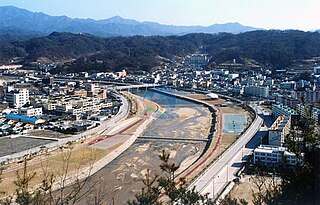
Yeongju is a city in the far north region of North Gyeongsang province in South Korea, covering 668.84 km2 with a population of 113,930 people according to the 2008 census. The city borders Bonghwa county to the east, Danyang county of North Chungcheong province to the west, Andong city and Yecheon county to the south, and Yeongwol county of Gangwon province to the north.

Bonghwa County (Bonghwa-gun) is a county in North Gyeongsang Province, South Korea. It lies inland, at the northern edge of the province, and borders Gangwon province to the north. To the east it is bounded by Yeongyang and Uljin counties, to the south by Andong, and to the west by Yeongju. The county is ringed by the Taebaek and Sobaek Mountains, the highest of which is Taebaeksan (1,566.7m). Because of its mountainous location, Bonghwa has a colder climate than most of the province, with an average annual temperature of 10 °C (50 °F).

The Yeongdong Line is a line of Korail. It connects Yeongju in North Gyeongsang Province with Gangneung in Gangwon Province. From Yeongju, it crosses the Taebaek Mountains and reaches the Sea of Japan at Donghae, thence proceeding north to Gangneung.

Gangdong District (Gangdong-gu) is one of the 25 gu which make up the city of Seoul, South Korea. Gangdong is literally "east of the (Han) River". It is located on the east side of the city.

A mining community, also known as a mining town or a mining camp, is a community that houses miners. Mining communities are usually created around a mine or a quarry.
Sangun-myeon is a myeon or a township in Bonghwa county of North Gyeongsang province in South Korea. The total area of Sangun-myeon is 58.52 square kilometers, and, as of 2006, the population was 2,070 people. Sangun-myeon is further divided into eight ri, or small villages.
Myeongho-myeon is a myeon or a township in Bonghwa county of North Gyeongsang province in South Korea. The total area of Myeongho-myeon is 114.38 square kilometers, and, as of 2006, the population was 2,428 people. Myeongho-myeon is further divided into eight "ri", or small villages.
Seokpo-myeon is a myeon or a township in Bonghwa county of North Gyeongsang province in South Korea. The total area of Seokpo-myeon is 150.1 square kilometers, and, as of 2006, the population was 2,144 people. Seokpo-myeon is further divided into three "ri", or small villages.
Socheon-myeon is a myeon or a township in Bonghwa county of North Gyeongsang province in South Korea. The total area of Socheon-myeon is 264.17 square kilometers, and, as of 2006, the population was 2,519 people. Socheon-myeon is further divided into seven "ri", or small villages.
Murya-myeon is a myeon or a township in Bonghwa county of North Gyeongsang province in South Korea. The total area of Murya-myeon is 109.26 km2 (42.19 sq mi), and, as of 2006, the population was 3,518 people. Murya-myeon is further divided into eight "ri", or small villages.
Jaesan-myeon is a myeon or a township in Bonghwa county of North Gyeongsang province in South Korea. The total area of Jaesan-myeon is 126.01 square kilometers, and, as of 2006, the population was 1,692 people. Jaesan-myeon is further divided into five "ri", or small villages.
Bongseong-myeon is a myeon or a township in Bonghwa county of North Gyeongsang province in South Korea. The total area of Bongseong-myeon is 66.69 square kilometers, and, as of 2006, the population was 2,583 people. Bongseong-myeon is further divided into seven "ri", or small villages.
Beopjeon-myeon is a myeon or a township in Bonghwa county of North Gyeongsang province in South Korea. The total area of Beopjeon-myeon is 70.22 square kilometers, and, as of 2006, the population was 2,368 people. Beopjeon-myeon is further divided into seven "ri", or small villages.
Chunyang-myeon is a myeon, or a township, in Bonghwa, North Gyeongsang in South Korea. The total area of Chunyang-myeon is 167.28 square kilometers, and, as of 2006, the population was 5,154 people. Chunyang-myeon is further divided into nine "ri", or small villages.
National Route 36 is a national highway in South Korea connects Boryeong to Sejong City, Cheongju, Chungju, and Uljin. It established on 31 August 1971.

Bonghwa is a town, or eup in Bonghwa County, North Gyeongsang Province, South Korea. The township Bonghwa-myeon was upgraded to the town Bonghwa-eup in 1979. Bonghwa County Office and Bonghwa Town Office are located in Naeseong-ri, which is crowded with people.
National Route 35 is a national highway in South Korea connects Buk District to Gangneung. It established on 14 March 1981.
National Route 31 is a national highway in South Korea connects Gijang, Busan to Singosan, Anbyeon. Due to the separation of Korean peninsula, it de facto ends in Yanggu It established on 31 August 1971.
The Bonghwa Geum clan is a Korean clans. Their bon-gwan is in Bonghwa County, North Gyeongsang Province. According to the research held in 2015, the number of Geum clan of Bonghwa was 23301. Geum clan began when Geum Eung founded Gija Joseon with Gija after Gija conquered Korea. Their founder was Geum Yong sik who worked as High Merit Minister in Goryeo.

Nuriro (Korean: 누리로) is a class of train operated by Korail, the national railroad of South Korea, it was introduced on June 1, 2009, to replace the short-range Mugunghwa-ho. The train was introduced as a replacement for the Bidulgi-ho/Tongil-ho/Mugunghwa-ho operating system between Seoul and Onyangoncheon, and will replace the short-range Mugunghwa-ho when a new train comes in. However, due to various problems, it is currently operating in Yeongdong Line and Jungang Line as a replacement for Mugunghwa-ho.







